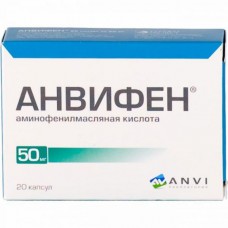Expiration date: 06/2026
Pharmacokinetics:
High absorption, good penetration into all tissues of the body and the BBB (brain tissue penetrates about 0.1% of the administered dose, and in young and elderly patients are much more).
Evenly distributed in the liver and kidneys. It is metabolized in the liver - 80-95%, the pharmacologically inactive metabolites. Not accumulates. After 3 hours, the kidneys starts output while the concentration in the brain tissue and is found not reduced for a further 6 hours about 5% is excreted unchanged by the kidneys partially -. With bile.
Description of the pharmacological actions:
Nootropic agent facilitates GABA-mediated neurotransmission in the CNS (direct effect on GABA receptors). Tranquilizing effect combined with an activating effect. It also has antiagregatsionnym, antioxidant and some anticonvulsant effects. It improves the functional state of the brain due to the normalization of metabolism and its effect on cerebral blood flow (increased volumetric and linear speed, reduces vascular resistance, improves microcirculation, renders antiagregatine action). It extends the latent period and shortens the duration and severity of nystagmus.
No effect on choline and adrenergic receptors. Reduces vasovegetative symptoms (including headache, a feeling of heaviness in the head, sleep disturbances, irritability, emotional lability). In exchange reception improves physical and mental performance (attention, memory, speed and accuracy of sensory-motor reactions).
Reduces the symptoms of fatigue (improves mood, increases the interest and initiative (motivation activities) without sedation or excitation. Helps reduce feelings of anxiety, tension and anxiety, normalizes sleep.
In the elderly does not cause CNS depression, muscle-relaxing-effect often absent.
Testimony:
asthenic and anxious-neurotic state
stuttering, tics, and enuresis in children
insomnia, night anxiety in the elderly
Meniere's disease,
dizziness associated with dysfunction of the vestibular apparatus of various origins
Prevention of motion sickness when kinetoses
in the complex therapy of alcohol withdrawal syndrome (for the relief of psychopathological disorders and somatovegetative).
Contraindications:
- hypersensitivity
- pregnancy
- breast-feeding
- Children up to age 3 years.
Precautions: in patients with erosive and ulcerative lesions of the gastrointestinal tract, liver failure.
Application of pregnancy and breastfeeding:
Contraindicated during pregnancy. At the time of treatment should stop breastfeeding.
Side effect:
Drowsiness, nausea. Increased irritability, agitation, anxiety, dizziness, headache (with the first receptions), and allergic reactions.
Drug Interactions:
It extends and enhances the effect of hypnotics, narcotic analgesics, antipsychotics, antiparkinsonian and antiepileptic agents.
Dosage and administration:
Inside, after eating, 2-3-week course.
Adults and children from 14 years of 250-500 mg 3 times daily (maximum daily dose of 2500 mg). The single maximum dose in adults and children 14 years of age is 750 mg in patients over 60 years - 500 mg.
Children from 3 to 8 years - 50-100 mg three times a day between 8 and 14 - 250 mg 3 times a day. The single maximum dose in children under 8 years of age is 150 mg 8 to 14 years - 250 mg.
Alcohol withdrawal syndrome: 250-500 mg 3 times a day and 750 mg at night, with a gradual decrease in the daily dose to adult normal.
Treatment of vertigo with vestibular dysfunction and Meniere's disease: 250 mg 3 times a day for 14 days.
Prevention of motion sickness - 250-500 mg dose 1 hour before the expected start of the pitching, or when the first symptoms of seasickness. Antiseasick Anvifena effect increases with increasing dose. When the express manifestation of motion sickness (vomiting, etc.) Appointment Anvifena ineffective even at doses of 750-1000 mg.
Overdose:
Symptoms: severe drowsiness, nausea, vomiting, hepatic steatosis (receiving more than 7 g), eosinophilia, decreased blood pressure, renal function.
Treatment: gastric lavage, the appointment of activated charcoal and symptomatic therapy.
Special instructions:
With prolonged use it is necessary to periodically monitor liver function and peripheral blood.
During treatment should refrain from potentially hazardous activities that require high concentration.




